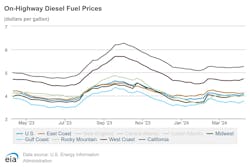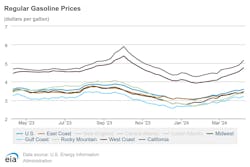The second full week of April, the U.S. Energy Information Administration (EIA) found that both diesel and gas prices rose sharply. This week, the national average for on-highway diesel fuel prices sat at $4.061 per gallon, according to the Administration. While this price is 3 cents cheaper than this time last year, it displays an increase of 6 cents since last week.
This price increase was echoed across the country, save for the New England sub-region, which saw no change in its diesel prices between this week and last. The Central Atlantic sub-region also saw its diesel prices increase by less than a cent. Overall, the East Coast area only experienced a 3-cent rise in its diesel prices to $4.118, as did California up to $5.259 per gallon.
On the larger end of the spectrum, the West Coast minus California saw a diesel price spike of 11 cents up to $4.257 per gallon, with the West Coast in total rising 7 cents to $4.723. Beyond the western area, the Gulf Coast also saw diesel prices increase 9 cents to $3.760.
With these changes in mind, the Gulf Coast is still the cheapest place to buy diesel fuel at $3.760 per gallon and is currently the only region with prices below $4. Meanwhile, California is still the most expensive at $5.259 per gallon.
Read more: No April fools, diesel average below $4, gasoline slows rise
This week, the AAA motor club logged their diesel price average at $4.044 per gallon, only 2 cents cheaper than the EIA’s reckoning. This is 3 cents higher than last week’s average of $4.018, and 16 cents cheaper than last year’s log of $4.208.
Gasoline sees over 20-cent increase in some regions
While not as extreme an increase as some individual regions, the nationwide average for regular gasoline prices rose 7 cents from last week to $3.591, according to the EIA. In fact, the only place prices did not increase from the week before was the Lower Atlantic sub-region, which saw gas costs decrease by less than a cent to $3.345.
Prices increased the least in the East Coast region, where gas pump costs went up by less than 1 cent to $3.391 per gallon. The Rocky Mountain area also saw a small price rise of only 2 cents to $3.380 per gallon. Prices on the West coast, meanwhile, rose by leaps and bounds. The West Coast including California saw a price increase of 19 cents to $4.748, while the West Coast without California went up 14 cents to $4.317, and California’s prices alone rose 23 cents to $5.142 per gallon. Even beyond the West Cost, both the Gulf Coast and the Midwest region saw their gas prices rise 9 cents to $3.125 and $3.460 per gallon, respectively.
Despite this, the Gulf Coast is still the cheapest place for gasoline, while California is the most expensive.
This week, the AAA’s record of gas prices is nearly identical to the EIA’s at $3.598 per gallon, which is 6 cents higher than last week and even higher than last year’s average, even if only by less than a cent. According to a press release from the motor club, prices likely rose due to increased tensions abroad.
“Renewed Ukrainian attacks on Russia’s oil infrastructure and increasing tension in the Middle East spiked oil prices recently,” said Andrew Gross, AAA spokesperson. “And with the cost of oil accounting for roughly 60% of what we pay at the pump, there will likely be some upward pressure on prices.”
This article was originally published on FleetOwner.com.
About the Author

Alex Keenan
Alex Keenan is an Associate Editor for Fleet Maintenance magazine. She has written on a variety of topics for the past several years and recently joined the transportation industry, reviewing content covering technician challenges and breaking industry news. She holds a bachelor's degree in English from Colorado State University in Fort Collins, Colorado.


